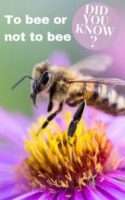Beside creating sweet honey for us, bees have another – even more important role in our ecosystem: Bees are responsible for pollination. Bees and other pollinators are important contributors to agriculture and food security.
According to the United Nations Environment Programme, of the 100 crop varieties that provide 90% of the world’s food, 71 are pollinated by bees. But did you know bees are endangered and some species are on the verge of extinction? Yup – like dinosaurs. According to the website depts.washington.edu, these are the reasons bees are becoming extinct:
-
- Parasites. There are two main parasites that are killing bees – tracheal and varroa mites. Tracheal mites live internally in the bee and kill them. The varroa mite lives externally in the beehive and affects young bees that are being raised. The diseases that are caused by the mites cause damage to the wings of the bees.
- Pesticides. The pesticides disrupt learning and memory in honey bees and several studies have shown solitary bees suffer the same kind of damage. At higher levels, the chemicals impair reproduction, such as by reducing the viability of sperm, leading to fewer offspring.
- Loss of habitat. As humans are expanding their cities and living communities, these need a lot of natural resources – and means cutting down many trees. Cutting down a lot of trees to make resources for human buildings and making spaces for these buildings contributes to the shrinkage of bee colonies because bees need large trees to build their homes.
- Cellphones. Bees are attracted to electromagnetic radiation. When a cellphone is being used, it emits electromagnetic waves – these damage a bee’s ability to return to its colony. The electromagnetic waves destroy the bees’ navigation system and they cannot remember where home is. The electromagnetic waves have been said to only affect honeybees and have not been proven to affect the whole beehive.
All these factors lead to what is called Colony Collapse Disorder (CCD), the phenomenon that occurs when the majority of worker bees in a colony disappear and leave behind a queen, plenty of food and a few nurse bees to care for the remaining immature bees and the queen. According to Wikipedia, most causes of CCD are still unknown, but the above four factors are being considered as possible causes. The Colony Collapse Disorder Working Group was established in 2007 to drill down on the causes, but still drew no strong conclusions.
South Africa is recognised as a bee diversity hotspot globally, according to the South African National Biodiversity Institute. South Africa has close to a thousand bee species. However, a lot of work needs to be done as South Africa is behind on tracking and documenting bee decline, since the entire globe is reporting ‘insect armageddon’ with declining numbers of insects, and most importantly bees.
Bee extinction is one of the high priority things to prevent in the world. According to Environment America, scientists say that “the three things we can do right now to save the bees are to plant more pollinator-friendly plants; stop the use of bee-killing pesticides in parks, wildlife refuges and other places bees should be safe; and promote sustainable, less pesticide-reliant agricultural practices.” Those of us who have gardens, can allow sections of it to grow wild and so encourage the growth of indigenous plant species whose flowers bees feed on. If you grow edible plants, even if only in containers, allow some of them to go to seed, as the resultant flowers are also food sources for bees.
If you enjoyed this article, you may also like It’s time to panic here
Tell us: Did you know of the important role bees play as pollinators of many of our food sources? And is there anything you, personally, can do to help stem the decline in their numbers?


